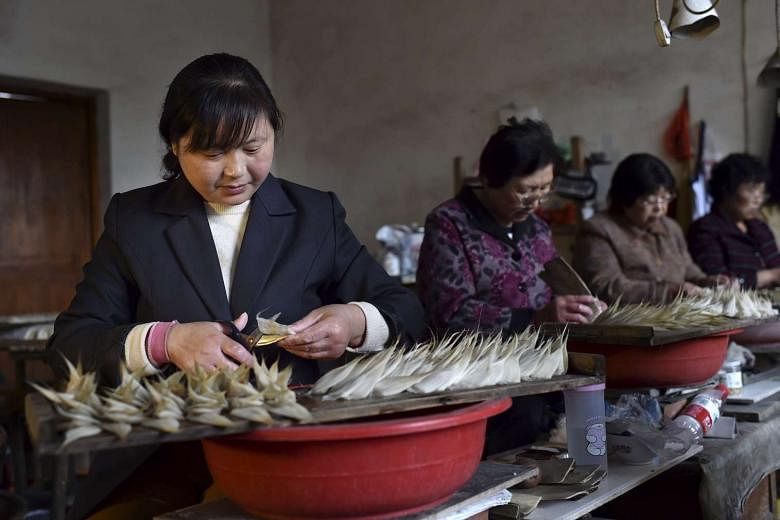Beyond the developments that hit the headlines, or the short-term spikes in financial markets, there's also a steady shift that underpins all of this, a steady shift to a new phase in global affairs. One that will be marked by slower economic growth, especially because of the changing demographics in a whole range of countries; slower growth in trade as well, especially because of the evolution of the Chinese economy; and a state of continuing tensions coming out of sectarian conflicts, now globalised.
But it's also a world of opportunities. And for a small country like Singapore, there's no lack of opportunity even in a world of somewhat weaker growth, a world with troubles that keep recurring. Opportunities that will come to innovative cities, to individuals with deep skills and to teams that bring people with the right skills together.
Part of the complexity that faces policymaking in both governments and businesses comes from the fact that we are seeing a confluence of both cyclical and structural forces in every major economy. In the United States, and especially in Europe and Japan, the cyclical challenge remains even years after the global financial crisis, which is to recover and get back to normal. In China, it's the other way round; it's about working out the excesses of the last few years, managing the slowdown and getting back to sustainable growth.
But whether it's moving from undershooting or overshooting towards the normal, these cyclical challenges are happening at the same time as deeper structural shifts in their economies: the longer-term trends that are taking them, and taking the world, from an old normal to a new normal.
Take the two largest economies - the US and China.
U.S.: JOBS, SKILLS, PENSIONS

Everyone is fixated on when the FOMC (Federal Open Market Committee) is going to raise interest rates - to get off from what they call the "zero lower bound" in interest rates. It's an important decision, but it's all about weighing up the cyclical movements of the economy and prices. Even then,
if you look at it over the last few years, I think it has to be said that monetary policy with massive quantitative easing and zero interest rates has not been very effective in stimulating a cyclical recovery in any of the advanced economies. And more importantly, monetary policy, although it's what headlines are often about, is not what determines the fundamentals that shape the future. And there are serious structural challenges that have yet to be tackled in the US.
Middle-class households have seen no increase in real incomes for a very long period of time - about 15 years or so. Jobs are also disappearing in the middle of the workforce. That's not a cyclical phenomenon. It began long before the global financial crisis.
At the same time, there's a large shortage of skills. So there are two things happening in the middle of the US workforce - jobs being lost, which is the traditional story of a "disappearing middle", but also jobs going unfilled because employers say they cannot find people with the right skills. There's a whole range of jobs requiring middle- and upper-end skills, whether it's nursing specialists, skilled technicians, a whole range of jobs for which employers can't find the right skills. That, too, is a structural challenge in the US and most advanced economies.

And third, not often noticed because it's a problem that's creeping on the US and much of the advanced world, is that there is a looming pensions and healthcare financing crisis. In time to come, that will be the big crisis. Pensions and healthcare financing commitments, what economists call "unfunded liabilities", are getting larger and with few serious solutions being proposed. So there are serious problems coming in much of the advanced world.
CHINA: MANUFACTURING SHIFT, COMPLEX REFORMS
China likewise faces a confluence of cyclical and structural forces.
It faces large overcapacity, or the overhangs following its efforts to stimulate its economy after the global crisis - overhangs in heavy industries, in the property market, and local government and corporate debts. Those are the cyclical forces, and they are leading to a significant slowdown in the short term. But China has also embarked on a fundamental shift in the nature of its economy, a change in the longer-term pace and composition of growth. It's moving away from investment-driven growth to an economy driven by consumption, and by services more than manufacturing.
But what has been less noticed is an important structural shift in Chinese manufacturing itself. Remember, China is still a manufacturing powerhouse. It has not lost but gained global market share in the last five years. There's
a shift that's taking place within manufacturing, where China is onshoring more of its production. We had a global supply chain that China was part of for many years, within Asia especially. Whatever China made, you'll find inputs coming from a whole range of countries. China is now producing more of those inputs itself, and hence lengthening its own value chain. That's a natural evolution in the Chinese economy. They are moving from labour-intensive, low-cost production, fitting together things that have been produced abroad, towards producing more of the higher value inputs themselves. That shift is having significant effects
around the world, especially for South Korea, Taiwan, Singapore and Japan which used to provide them with these inputs.
Most fundamentally, China has embarked on reforms leading to a market-driven economy, and that's the most complex economic reform agenda anywhere in the world. It requires great adroitness, to avoid upsetting the cart and setting back the whole reform process. Reforms of the state enterprise sector, and the progressive liberalisation of the financial sector.
But even if China succeeds in its reforms, it is an economy moving to a slower path of sustainable growth. Its working age population is already beginning to decline in absolute terms. So it will be growth driven not by employment but by innovation and technology. Foxconn plans to introduce a million robots, and the economics is clear. The industrial robots of today are already cheaper than the average worker in Chinese factories. China is going to be the largest user of industrial robots in the world by next year, larger than the major European countries combined, larger than the US. Vanke, their largest property developer, plans to substitute one third of jobs with robots - to clean the floors, guard buildings and drive around residential estates.
Technology is being introduced at a remarkable pace in China and it's going to drive their growth. Still, it will be slower growth, and especially after 2020. It will have to come entirely from productivity growth, and even though the Chinese economy as a whole is still catching up from a low level, it will be difficult to sustain growth at more than 6 per cent beyond this decade.
It is the structural forces, more than the cyclical, that will weigh heavily on every economy in the coming years. Demographics alone, the slowing of labour force growth, would subtract 1 percentage point of gross domestic product (GDP) growth globally over the next 20 years, compared with the last 20.
THE PRODUCTIVITY GAP
But if the demographics is not helping, what about productivity? Productivity growth, which is still a bit of an enigma, has slowed significantly almost everywhere in the last five years. In the major advanced economies, it's been less than 1 per cent per year in the last five years, after growing at about 2 per cent for a decade and a half before that. There's a wide range of views on how this will shape out in future. The techno-optimists point towards what's already happening at the cutting edge - in robotics, in the "Internet of Things", in big data and artificial intelligence. But the argument is about whether what's happening in leading firms, those at the cutting edge of these technologies, is going to be spread throughout their economies. There has not been much evidence of that diffusion across the economy so far, and the gap in productivity between the leading global firms and the rest has in fact widened greatly in the last decade. We cannot say yet if the techno-optimists or techno-pessimists will be right.
But it would not be prudent to bet on a sharp revival any time soon. Taken together with the demographic forces, we have to expect slower growth for many years to come.
Trade growth, too, is slowing.
For the first time since the 1970s, it is growing more slowly than global GDP. I don't myself think that this is going to be a continuing slowdown, and it doesn't change the fundamental advantage in any economy that comes from trading with the world. But the shift that's taken place is not surprising and it could continue for a number of years. We are seeing slower trade growth particularly because of what's happening in China - China demanding less inputs and raw materials from the rest of the world - and we've seen the end of the commodity super-cycle. And slower trade is also because of the shift in economies of the advanced world from manufacturing to services, which is less import-intensive.
S'PORE'S INNOVATION CHALLENGE
How does this come together for Singapore? We, too, are faced with cyclical headwinds.
The manufacturing economy is effectively in a technical recession. Overall, we are still growing, we're not in recession, but we're growing below what would be our medium-term potential. But beyond the cyclical forces, which we have to watch carefully over the next year, it is the structural challenges that we, too, have to be focused on in Singapore.
We have to get used to the fact of a tight labour market. By 2020, we're down to virtually 0 per cent domestic labour force growth. We will need foreign labour in various sectors but we can't grow the foreign labour force indefinitely, or increase the proportion of foreigners relative to locals indefinitely. So we have to get used to lower labour force growth. The only way we can grow is by making significant improvements in every sector, bring in new ways of business, so as to raise productivity. That's not just the only way to grow the economy. It's also the only way to sustain income growth for the middle class, and those with lower wages too.
The electronics industry is an example. It's been hit by strong cyclical headwinds - like in Taiwan, South Korea and Hong Kong. But we are also seeing a reconfiguring taking place in our electronics industry - the introduction of frontier technologies, and a move towards high-value production. Micron, for example, is investing US$4 billion (S$5.6 billion) in a new facility by 2017, to produce 3D Nand flash - that's cutting-edge. There's also a service side to this - the design work and other services that come with advanced manufacturing. Out of the current cyclical weaknesses, we've got to make these structural moves, reconfigure and move towards much higher-value activity.
What it comes down to is to grow through innovation. It means becoming an innovative society. That's what we're moving towards. And that's what will best assure us of progress even in a world of troubles and weaker growth.
It means a few things.
First and most importantly, SkillsFuture. Up and down the ladder, across all types of jobs, whether you're helping out in elderly care, in the local community, or a driver working with technology in domestic logistics so that one person does the job that four people did previously, whether you're in finance where you have to get used to disruptive technologies that will take over a whole set of routine functions that were previously done by people: Everywhere, we have to equip people with the skills that enable them to work in a technology-enriched world, so that we preserve jobs and so that jobs get better.
We can do it. Through SkillsFuture, we're going to invest in every individual throughout life. It's not just what happens in the first 12 or 16 years of your education. It's throughout life. And we have to reduce our focus on the grades you get early in life, and increase our focus on investing, in developing everyone's abilities and skills through life.
Second challenge, we have a dual economy. The firms that are dealing with the world - typically the larger firms but we also have small firms exporting or investing abroad - have been doing well. They've shown robust productivity growth. But there's a large segment of the economy, particularly in domestic services, in construction, where productivity growth has been weak. So it really is a dual economy, like in some other advanced economies. And we've got to crack that duality. We've got to work cluster by cluster, industry by industry, to develop chains of innovation that combine the strengths of large firms with the small, combine the foreign with the local firms. We have to develop innovation and skills collectively, in each supply chain and throughout the economy so that innovation becomes pervasive.
CULTURE AND CREATIVITY
The third factor comes down to culture. Innovation is not just about having broad ideas of change.
It also requires, first, deep specialist skills. Whether you look at the German firms that are at the frontier, or the Japanese or Swedish in various industries, when you visit them, when you look at why they are world leaders, you will find people who have deep mastery of skills. Not that they were highly educated when they were young, but they are developed through life and they become masters of what they are doing.
It's not just a matter of training schemes and WDA (Singapore Workforce Development Agency) incentives. It's about a culture - taking pride in mastery and getting respect from customers and the public because you're the master of what you're doing. That's a culture we must aspire towards.
We need to also change the culture in education, and that involves all of us - parents, teachers, students. So that when children are young, we are less obsessed by the grades they get and how finely we can differentiate one child from the other, and focus more on giving them diverse experiences. No one knows for sure how we get creative people. But there's one thing that there is some consensus on, and backed by science, which is that diverse experiences help, particularly as you grow up. Diverse experiences and interaction with people from diverse backgrounds, that helps. And that means everything you do on the sports field, in the dance hall, in debate, in outdoor adventure. And even when you're just daydreaming. There's something that studies of the human brain over the last decade tell us.
They've got these high-resolution brain-imaging experiments that show how your brain works when you're doing different activities. And the brain process that's working when you're engaged in creative activity, when your brain is going beyond existing boundaries, is the same brain process that lights up when your mind wanders and meanders.
We've got to let children have enough time to flex that part of their mind as well when they are young. And give them many more, diverse experiences.


